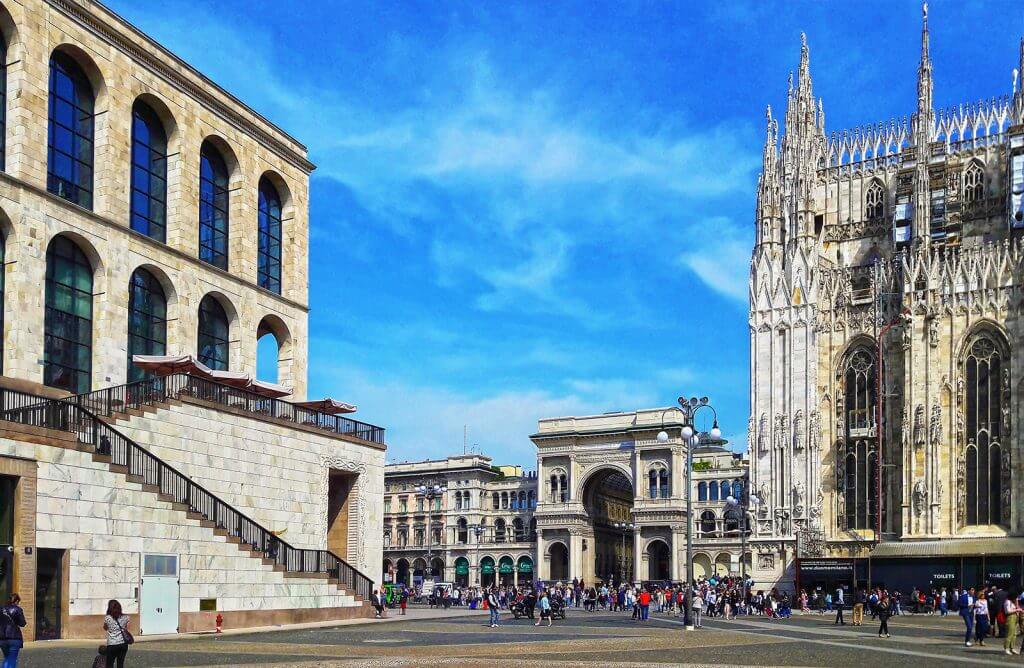The most complete guide on the web about what to do in Milan
The most important places to visit
History of Duomo di Milano
Brief history of the Duomo
Beginning of construction of the Milan Cathedral (1386-1387)
Archbishop Antonio da Saluzzo began construction of a new cathedral, to be built on the site of Basilica of Santa Maria Maggiore and dedicated to Santa Maria Nascente.
The Visconti era (1387-1447) Lord of Milan Gian Galeazzo Visconti founded the Veneranda Fabbrica del Duomo with the aim of carrying out the planning, construction and conservation of the cathedral and who decided to replace traditional milanese bricks chosen for the construction of the Duomo, with marble from the Candoglia quarries.
Architects, sculptors and craftmen from all Central Europe got in Milan, attracted by the magnificence of the project. The Sforza era (1450-1520) The building extends the aisles up to the last third span, first minor spire sculpted by Amadeo (Gugliotto dell’Amadeo) was built and the most beautiful stained glass windows were installed.
The Borromeo era (1560-1650) Under the archbishops Carlo and Federico Borromeo the style of the Duomo was influenced by the Catholic Reformation, and examples of this influence are the ‘Quadroni’ or large paintings of San Carlo and the wooden choir.17th-18th Centuries (1650-1800)
The crossing was completed with the main spire and the Madonnina statue crowning it. 19th Century (1800-1900)
In this period the facade and the ornamental elements were completed.
The historiated stained glass windows date from this period, but were made using enamel painted glass. From the 20th century to the present day (1900 to date) This has been the period of major restoration work, in which the first archaeological excavations were made in the Cathedral Square.
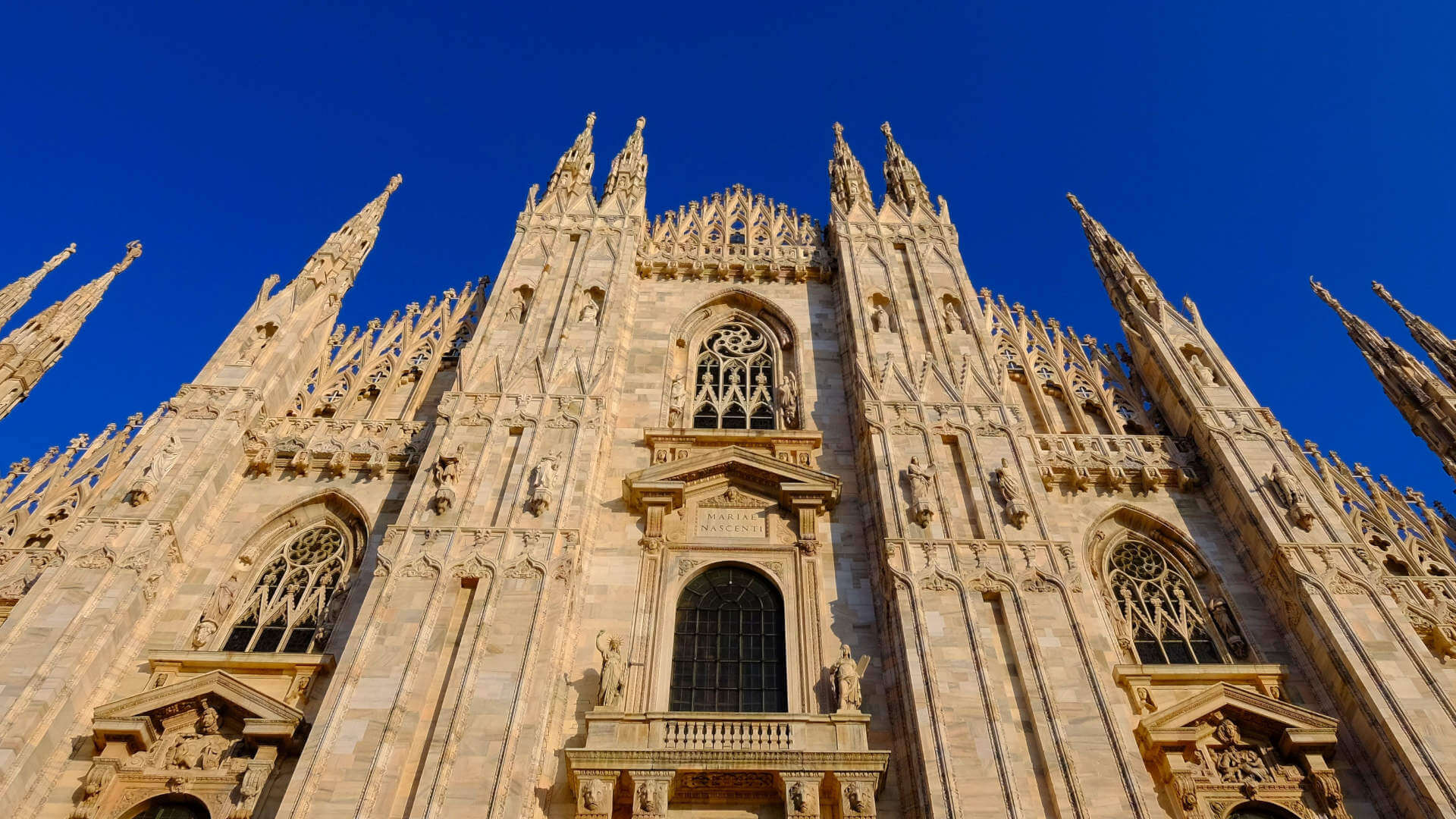
The city of Milan is home to a truly inestimable treasure speaking of the Gothic architecture of Northern Italy.
The Duomo is undoubtedly the most beautiful and fascinating monument of the city of Navigli.
This cathedral, which is the fourth largest in Europe, is the most important of the Milanese archdiocese and is the seat of the parish of Santa Tecla.
We know that this magnificent masterpiece of gothic art is dedicated to Santa Maria Nascente and it’s situated in the homonymous square.
Following this little guide, in which I will explain how and why to visit the Milan most beautiful Cathedral, you will discover what makes this monument so unique.
Visiting the Duomo of Milano
The first thing that hits you is the exquisite Lombard Gothic architectural style of the Duomo of Milano.
Beyond the artistic value and the beauty of this church, what captures the attention is its grandeur. The Duomo of Milano is the second largest Italian church for area, just after the St. St. Peter’s Basilica in Rome.
The dizzying height of this magnificent cathedral is enhanced by the gothic spires, fascinating pyramidal structures that reach up toward the skies.
Admiring the Duomo from below is a truly unique experience, not to mention reaching up to the roof, where you will see spires and sculptures from a close-up and the main spire, which hosts the golden statue of the Virgin.
Visiting the cathedral
Those who have a huge passion for the art, the history and the culture of our country will be enchanted by the facade of the Duomo. Moreover, the sculptures and refined decorations inside the cathedral will capture the eyes of any Italian or foreign visitor.
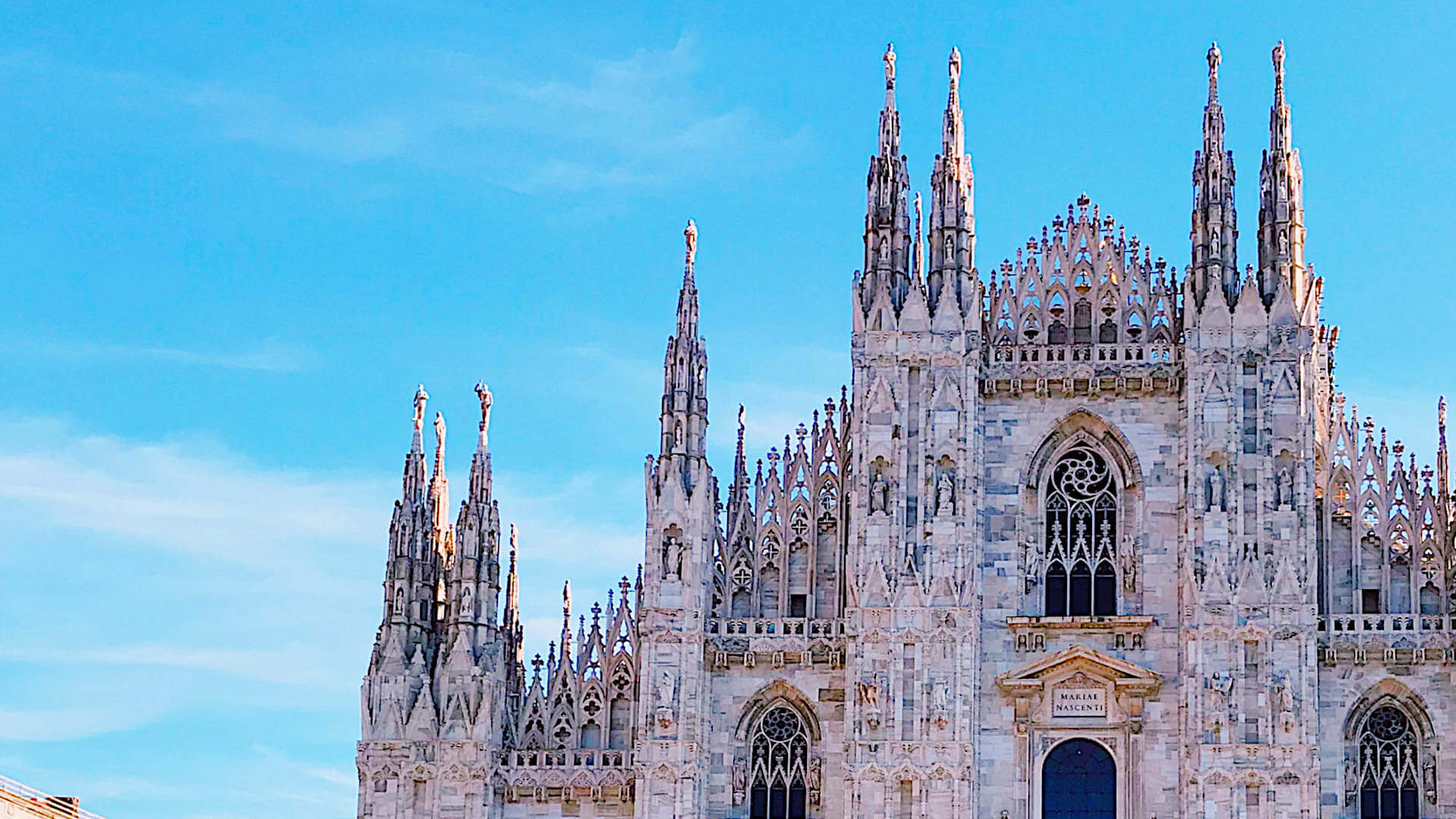
The drawing of the facade is Pellegrino Tibaldi’s masterpiece and dates back to 1580. Among the various architects, engineers and consultants who worked at the construction of the cathedral, we must remember Leonardo da Vinci and Donato Bramante.
The plan consists of a nave with four side-aisles, crossed by a transept and then followed by choir and apse.
Discovering the paintings and the sculptures
The stained glass windows surround the Gian Galeazzo Visconti emblem.
There’s plenty of masterful paintings and sculptures inside the cathedral, among the most important paintings: “Visit of Sant’Agata in Carcere by San Pietro” by Federico Zuccari, and the famous “San Bartolomeo Scorticato” by Marco D’Agrate, just to name a few.
The planetarium
Planetarium of Milan
The neoclassical building of the Platenarium is located on the edge of the Giardini Publici, and is a stone’s throw away from the Natural History Museum. It was originally built by architect Piero Portaluppi for the Swiss publisher Ulrico Hoepli, who donated it to the city of Milan after its inauguration in 1930.
Please read the following guide to discover everything about visiting the Planetarium.
Structure
The Planetarium of Milan has an octagonal base and features the largest projection room: its reproduction dome nd it is 19.6 meters in diameter, with an overall capacity of 320 seats.
Milan Planetarium is a teaching Museum building with the dome, inside which to project the image of the stars and their movements in the sky.
Meetings, conferences and laboratories are available all over the year, astronomy experts provide the families and the students with clear and detailed information on the stars, planets, galaxies and constellations brilliantly answering to every type of curiosity and questions.
How to reach it
The Planetarium of Milan can be reached by the Milan Metro taking Line 1 and getting off at Porta Venezia stop not far from the building, changes for the Line 1 are available at Central Station stop, Cadorna Station and Loreto, or by car, leaving the car at the paid parking close to the Planetarium.
Meteorites
As you enter the Planetarium of Milan, you won’t miss the marvellous meteorite exposure in the atrium, then going downstairs reach the circular hall of the dome where you will see the gigantic Zeiss IV star projector, which has been in use since 1968.
The stars and celestial bodies are projected onto a screen made up of panels aluminum drilled, and the sky is shown from different latitudes, allowing visitors to watch the rise and fall of the stars from every point of the planet and during the various seasons.
Multimedia system
The Planetarium of Milan is equipped with a very sophisticated multimedia system with three video projectors featuring two lasers controlled by a computer, which is able to create and transmit photographs, drawings, shots and special effects, making the whole universe playback very realistic.
Families with children can take part in guided tours of the sky, dedicated to those who are approaching this interesting scientific subject for the first time, or participate in events especially designed for children and teenagers where to learn astronomy by fun thanks to narrative techniques that come from the theatre.
For children and parents the starry sky will no longer be something ordinary but an extraordinary experience.
Pinacoteca di Brera
Brera is a exquisite area with lots of pedestrian streets where to find antique shops, art galleries and many places where to have lunch or a drink.
The name “Brera” comes from the Lombard word “braida” which means a field or a grassy area close to a city.
The order of the Umiliati settled in this area of the city in 1201, building a church, a convent and some wool production laboratories.
Three centuries later, the property handed down to the Jesuits, who began the construction of the Palazzo di Brera,
and then in 1772 to the Austrian state property.
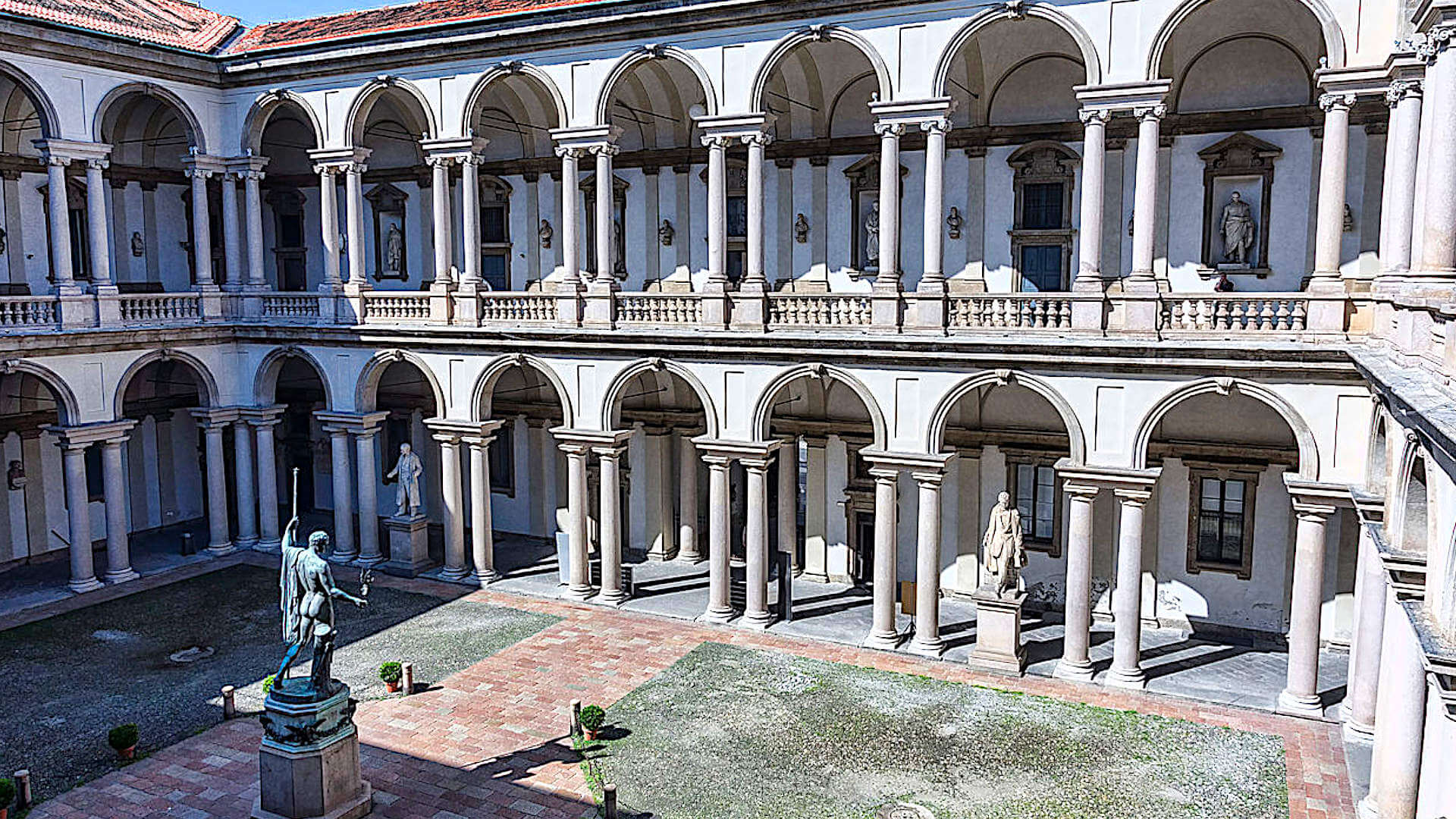
During the Risorgimento, Brera was the cradle of the Scapigliatura literary movement but even in more recent times it has continued to welcome poets, writers and artists such as Buzzati, Montale, Gadda and Lucio Fontana or Piero Manzoni.
The Pinacoteca is located in the great Palazzo di Brera, which also houses the Braidense National Library, the Brera Observatory, the Botanical Garden, the Lombard Institute of Sciences and Letters and the Academy of Fine Arts.
Entering the courtyard of the palace you won’t miss the great monument to Napoleon I.
By Napoleon’s will, this place was transformed into a museum when Milan became the capital of the Italic Kingdom.
Paintings confiscated from churches and convents throughout Lombardy began to pour into the museum in the early years of the 19th century, soon to be joined by artworks of similar provenance from other areas of the Kingdom of Italy.
Unlike other important museums in Italy such as the Uffizi, Brera did not start out life as the private collection of a prince or nobleman but to offer the students the opportunity to study lofty masterpieces of art close up.
What to see
The Pinacoteca di Brera is one of the most important museums in Italy and includes some of the greatest masterpieces of Italian and foreign art.
Visiting the gallery should take at least 3 hours as every work displayed is worth seeing, just to mention a few:
The Marriage of the Virgin (Raphael)
The Marriage of the Virgin (Raffaello), this is one of the artist’s most famous painting, it closes the youth period and marks the beginning of his artistic maturity.
Completed in 1504, the painting depicts a marriage ceremony between Mary and Joseph.
The intense use of color, with a better rendering of plasticity and warm atmosphere, thanks to a wider range of shades than that of the fifteenth-century painters, projects Raphael towards the conquest of the grand manner.
The Dead Christ and Three Mourners, Andrea Mantegna
Famous and powerful painting in which the dead body of Christ is represented by an original and unique point of view.
The composition produces a great emotional impact, accentuated by the extreme foreshortening: Christ’s body is very close to the viewpoint of the observer who, looking at it, is drawn into the center of the drama; moreover, every detail is enhanced by the incisiveness of the lines, which compels the gaze to linger over the most terrible details, over the members stiffened in rigor mortis as well as the wounds, ostentatiously presented in the foreground as called for by the tradition of this type of image.
The Virgin with Child, Angels and Saints
The Virgin with Child, Angels and Saints (Pala Montefeltro or Brera Madonna) is a painting by Piero della Francesca, tempera on panel.
The Brera altarpiece is an example of the perspective research carried out by the artists of central Italy in the Renaissance.
The painting is a magnificent work, with a marvellous use of light and shades and iconography of extraordinary richness.
Both the dimensions and the absence of side compartments are unusual, as in the traditional polyptychs, resulting in the first Sacra Conversazione mainly painted vertically: numerous altarpieces throughout the central-northern Italy are inspired by it.
The Kiss, Hayez
It is an 1859 painting by the Italian artist Francesco Hayez which represents a couple from the Middle Ages, embracing while they kiss each other.
The painting represents a couple from the Middle Ages, embracing while they kiss each other. It is among the most passionate and intense representations of a kiss in the history of Western art.
The painting aims to portray the spirit of the Risorgimento, enabling the latter to unify the many states of the Italian peninsula into the new kingdom of Italy.
This painting has been regarded as a symbol of Italian Romanticism, The Kiss has enjoyed extensive popularity from its exhibition onward, especially in Italy, so much so that it was reproduced by Hayez in three other copies, with very little changes between them.
Supper at Emmaus, Caravaggio (Michelangelo Merisi)
The painting is one of the versions that Caravaggio dedicated to the episode narrated in the Gospel of Luke, the characters are portrayed to bring out their features and the theatrical treatment of light underscores the sacred nature of the moment.
Looking at the table you will surely remember the famous Caravaggio Basket of Fruit painting and his masterful realistic reproduction of the human state.
The Finding of the Body of Saint Mark (Tintoretto)
This painting literally leaves you speechless, it represents the moment when San Marco appeared to some Venetians unveiling the place where his body was buried ending the profanation of the tombs.
Human Flood (Pellizza da Volpedo)
It certainly doesn’t go unnoticed, at least because it occupies the whole wall of the hall. The painting represents a human flood of workers on strike; however, the canvas remained unfinished and was abandoned by the artist for a while until a few years later, in 1898.
How to get
By public transport Pinacoteca di Brera is in via Brera 28 in Milan UNDERGROUND: the nearest stations are Lanza (M2 line), Montenapoleone (M3 line) and Cairoli (M1 line) BUS: the nearest bus stops are via Monte di Pietà or via Pontaccio (route 61) and Foro Bonaparte (route 57) TRAM: the nearest stops are via Cusani (routes 1-2-12-14) and Lanza (route 4)
CAR: The nearest parking spaces can be found in via Brera.
Leonardo Da Vinci National Museum of Science and Technology
The museum is in the very heart of Milan, a few steps away from the Basilica of Sant’Ambrogio, it is the largest museum of science and technology in Italy, one of the most important ones in Europe and in the world.
This heritage witnesses the history of science, technology and industry, starting from the 19th century to the present, with particular reference to Italy.
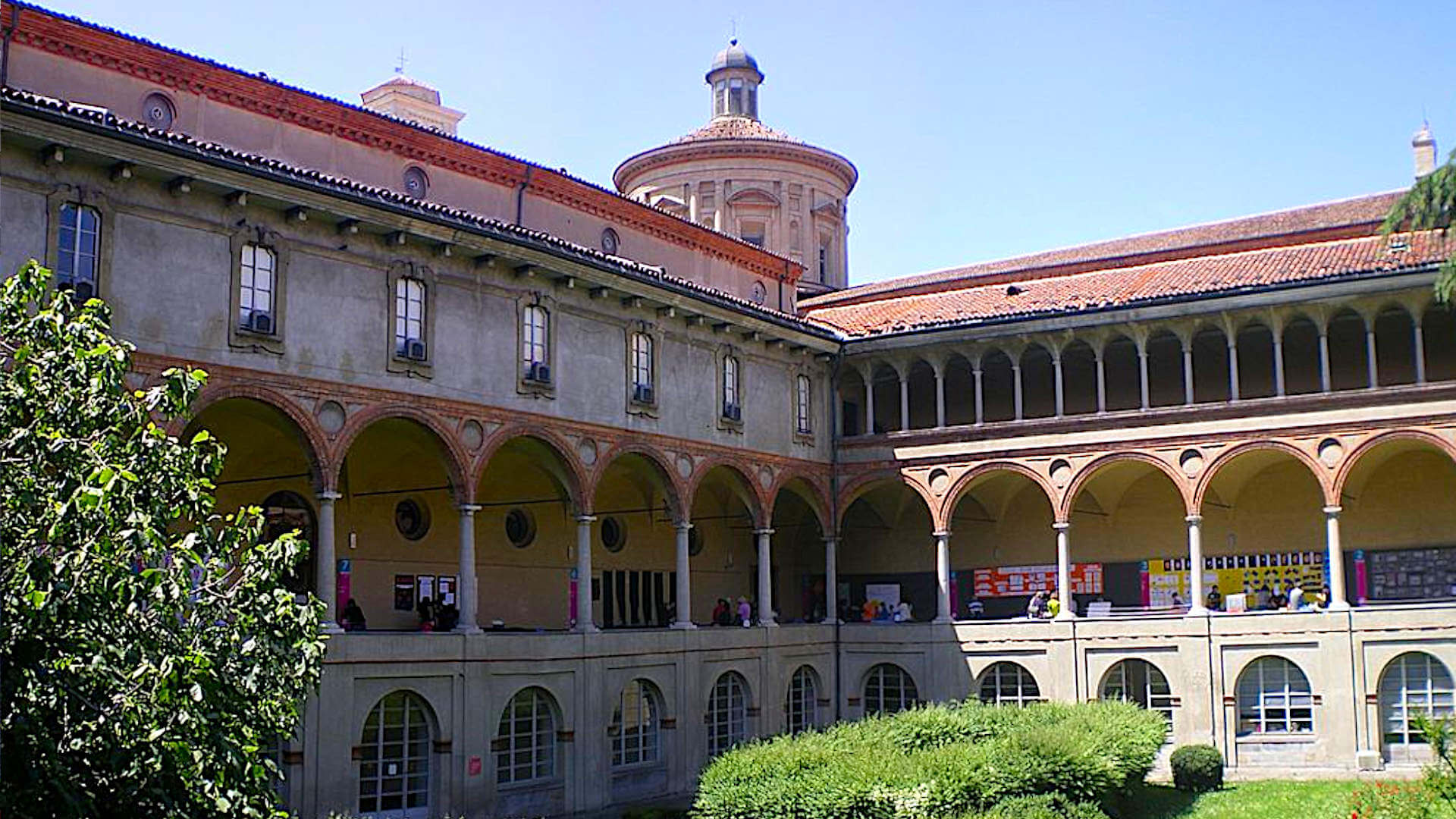
The central body of the Museum was built in the early 16th century as a monastery to host the monks of the Olivetan order.
From the 50’s the museum added a gallery dedicated to Leonardo da Vinci with models and drawings of the machines of the Florentine genius.
At the entrance the ’Regina Margherita’ steam machine is on display, inaugurated by Queen Margherita di Savoia in 1895 and used until the early twentieth century to generate electricity in the Egidio and Pio Gavazzi silk factory in Desio.
The central body hosts most of the historical collections and the interactive areas then developed over the years in a adjacent area together with the construction of the large pavilions for the transport collection.
The Aeronavale Pavilion (1973) hosts the schooner Ebe and the deck of the transatlantic Conte Biancamano and the AC72 Luna Rossa catamaran, plus, some replicas describing the history of the flight.
At the first floor there is a collection that traces the history of flight, from the pioneering years to jet aircraft.
The Railway Pavilion (1967) hosts about twenty locomotives and railway carriages and instruments used to conduct rail traffic. Outside the two pavilions dedicated to transport history, there’s the S-506 Enrico Toti, the first submarine built in Italy after the Second World War, on display since 2005.
The other exhibition areas are dedicated to materials, energy, communication, space, nutrition, particle physics and of course to Leonardo da Vinci.
Together with the research and conservation of scientific and technological heritage, the museum has always carried out an intense educational activity, using an informal approach and experimenting with methodologies, tools and activities to involve the people.
More than 17.000 technical-scientific and artistic objects make up the museum’s collections, most of them belonging to the 19th and 20th centuries.
In addition to permanent collections and interactive workshops, the museum puts on temporary exhibitions, theatrical performances, conferences, meetings with experts and special events to contribute to spread science among the citizens.
Don’t miss
The submarine S-506 Enrico Toti is worth a visite inside with the assistance of a guide (additional ticket can not be sold separately).
The Space Area hosts some celestial globes from the XVII-XVIII centuries, interactive installations, technological finds from the missions and a portion of the ISS (International Space Station) reconstruction, it also keeps a fragment of lunar rock collected by the astronaut Eugene Cernan in December 1972 during the exploration of the Taurus Littrow Valley, on the last Apollo mission
The museum holds the most important historical collection in the world of machine models based on the academic interpretation of Da Vinci’s drawings.
The AC72 catamaran “Luna Rossa” that reached the final in the Challengers Selection of the 34th America’s Cup in 2013 on display in the Aeronavale Pavilion at a height of 5 meters.
The recent permanent exhibitions “#FoodPeople: the exhibition for those who are hungry for innovation” and “Extreme, in search of the particles”.
On weekends and holidays, activities in the interactive workshops, in the Tinkering Zone or in the Maker Space, guided tours and special events are included in the admission ticket.
Castello Sforzesco
After coming to Milan in the 15th century, Francesco Sforza builded a castle on the ruins of the Visconti castle which was demolished after the end of the dynasty.
The new building was not just a restoration of the family tradition but also a way to magnify the power of the dynasty with something great.
The castle, restored by Luca Beltrami between the late 19th and early 20th century, is now home to many cultural events as well as a tourist destination of undoubted charm.
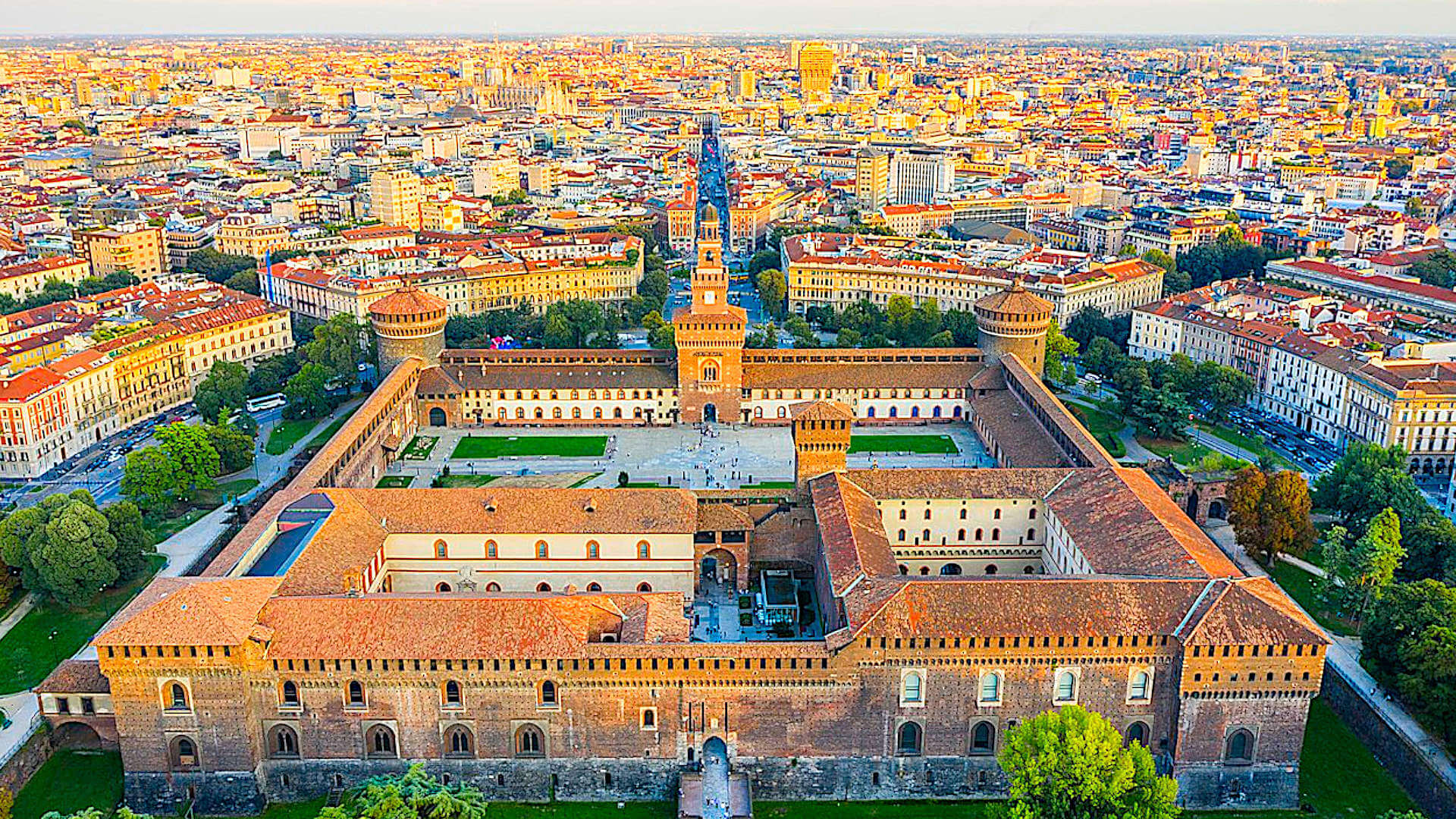
The building
The best way to start visiting the Castello Sforzesco is trying to understand the area.
This imposing building features ancient defences, courtyards, towers and striking battlements.
The walls, once useful for the protection of the castle, have been modified over the centuries and were partly designed by Leonardo Da Vinci himself.
One of the most important courtyards is the Courtyard of Arms recently restored by the architect Luca Beltrami.
This courtyard keeps many architectural elements of ancient Milan that offer the visitor a small window on the past.
Biblioteca Trivulziana
The collection includes ancient and noteworthy manuscripts, still well preserved: from the 8th century to including a codex of the Divine Comedy dating to 1337 and the autographed notebook of Leonardo da Vinci.
The current embodiment dates back to 1935, when the City of Milan acquired the Trivulzio collection.
In 1978 a restoration workshop for antique books, documents and bindings was created within the Archivio Storico Civico e Biblioteca Trivulziana.
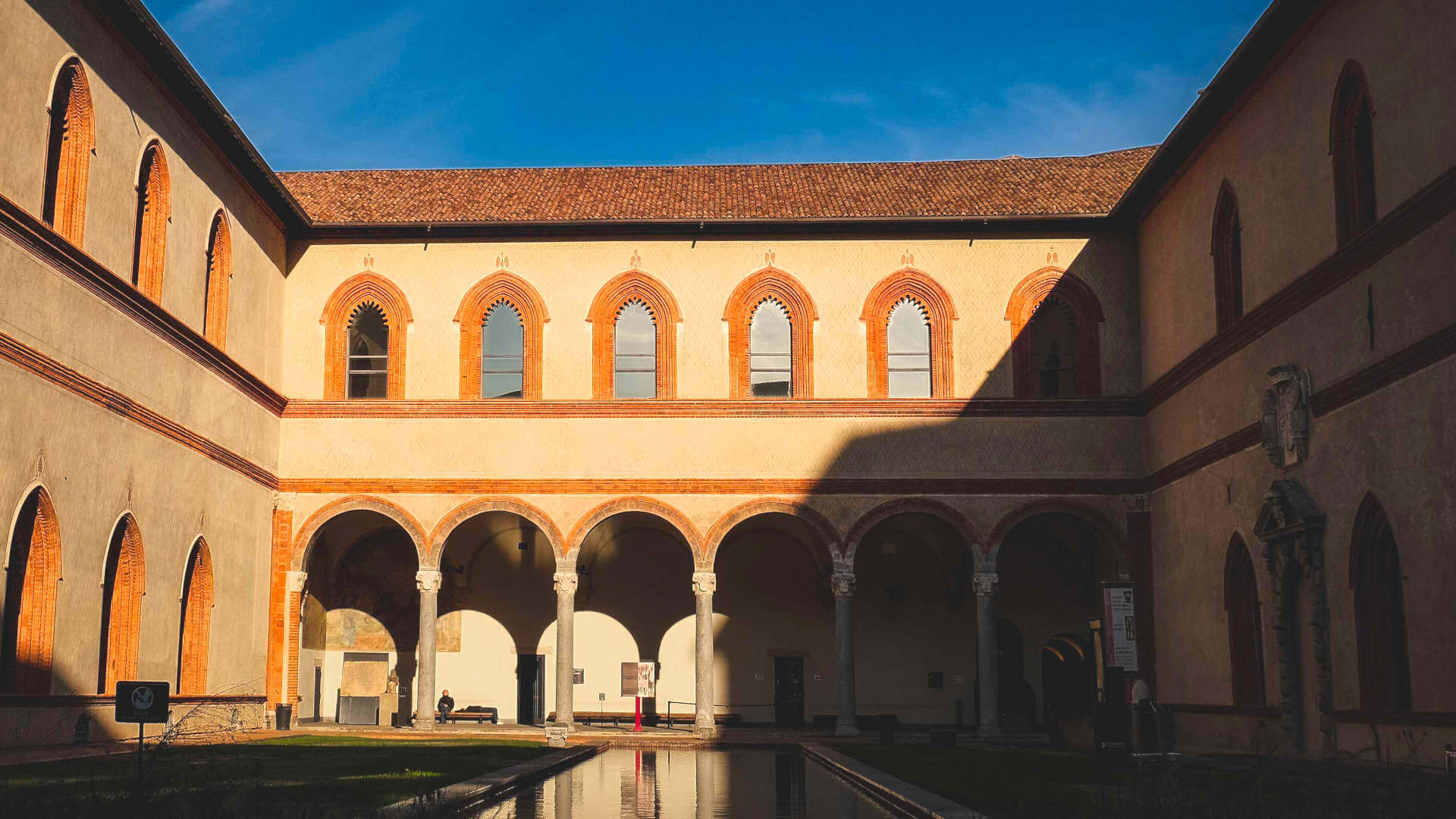
The museums of the Castello Sforzesco
The inner part of the Castello Sforzesco houses the homonymous museums, the countless rooms of the castle are now visited by thousands of visitors each year.
The museums include the art gallery, the museum of prehistory, the Egyptian museum, the museum of ancient art, the one of musical instruments, extremely varied and interesting, and rooms dedicated to furniture and applied art.
Thanks to such spaces visiting the Sforzesco Castle is so much evocative and bewitching.
Temporary exhibitions at the Castello Sforzesco
If you plan to visit the Castello Sforzesco, take a look at the countless temporary exhibitions that the building puts on.
The castle hosts every year many temporary exhibitions, it won’t be be difficult to see exhibitions about the building itself, but also exhibitions of contemporary art, design and graphics.
Parco Sempione
Behind the Castello Sforzesco there’s Parco Sempione, where once there was the Ducal Park then downgraded to Piazza d’Armi.
The park includes the Arena which hosts sporting and musical events and the Palazzo dell’Arte, home of the prestigious Triennale di Milano.
At the end of the park there’s the Arco della Pace, built to celebrate Napoleon but then completed by the Austrian Empire.
Castello Sforzesco is open from Monday to Sunday from 7 to 18 in Winter and from 7 to 19 in Summer.
Admission ticket is 5 euros.
The museums open their doors every day except on Monday from 9 to 17.30.
THE LAST SUPPER
The Last Supper by Leonardo da Vinci was painted between 1495 and 1497 in the dining room of the Convent of Santa Maria delle Grazie.
It is an enormous painting that measures 640 cm x 880 cm. Leonardo da Vinci used tempera and oil on a base of plaster, instead of using the most frequent technique of the time: fresco.
The creation of The Last Supper
The Dominicans asked to the greatest artist of the time to decorate their temple thanks to Ludovico Sforza, (Duke of Milan from 1480 to 1494) who wanted to convert the convent into a mausoleum.
Nevertheless, Ludovico didn’t manage to make his wish come true as he lost his power and died imprisoned.
Leonardo da Vinci investigated the theme relentlessly and made numerous sketches before painting the scene. Those that witnessed the artist working on his painting say that he behaved extremely strangely during the whole process. Sometimes, he would start painting at dawn and wouldn’t even stop for lunch and at other times he would wander the streets looking for people to inspire him, or he would just stare at his work in a daze.
Fun fact: da Vinci did not get paid for this work of art, even after dedicating three years of his life to it, nor did he seem to want to be paid.
A survivor
The painting suffered with the passage of time since it was painted on dry plaster. The work started to flake off as soon as the painting was finished. During the eighteenth and nineteenth centuries, there were several failed attempts at restoration.
During the French domination, the Napoleon troops would use the wall for target practice and in 1943 the building’s roof was bombed leaving the Last Supper out in the open for several years.
After years of accurate restoration, The Last Supper has regained some of its original beauty and can be observed by those who book their visit in advance.
Fun facts about the painting
Even though the subject has been represented in thousands of occasions by various artists, Leonardo captured one of the most crucial parts of the dinner when Jesus announces that one of his apostles will betray him. The painting is so powerful and realistic that it expresses the astonishment, horror and surprise of his disciples.
Although da Vinci had named all the apostles in his sketches, some of the figures are not very clear. For example, the figure next to Jesus looks very feminine so many experts believe it to be Mary Magdalene, instead of the apostle John.
This idea is also represented in Dan Brown’s book, The Da Vinci Code, where he identifies the person on Jesus’s right to be Mary Magdalene and gives the painting an esoteric meaning. The film The Da Vinci Code was released in 2006 starring Tom Hanks and Audrey Tautou based on Dan Brown’s novel.
Book the tickets in advance
If you would like to see The Last Supper it’s advisable to book in advance calling the following number: +39 02 92 800 360.. The visits are set in small groups, which rotate every 15 minutes, making it a very enjoyable visit. Note that you are not allowed to take photos.
Santa Maria delle Grazie
The church and convent Santa Maria delle Grazie was established in 1463 as part of the Dominican Order by Guiniforte Solari. Years later, it was completed by Bramante in 1492, who built a beautiful dome, a cloister, refectory and semi-circular apses.
Comparing Santa Maria’s architecture with the rest of the churches in Milan, it certainly does not stand out. It is thanks to the painting of The Last Supper that it has become renowned worldwide.
A small part of the Pinacoteca Ambrosiana’s collection is contained in the temple’s sacristy. Tourists will be able to observe some of the pages of the Codex Atlanticus. However, in our opinion it’s not worth seeing. The most interesting exhibition is in the Biblioteca Ambrosiana.
Cimitero Monumentale
Designed in the early 19th century, when the City of Milan hosted a competition for a new cemetery that would have grouped the burials distributed in the six peripheral cemeteries in one place, the Cemetery was officially inaugurated in 1866 and soon became an elite cemetery for the people who had given prestige to the city of Milan.
Carlo Maciachini, the architect who designed the cemetery, conceived it as a garden and not just a funeral place, that’s why it is surrounded not by walls but gates.
The cemetery includes 3 distinct areas: the central and largest one is dedicated to the Catholics, on the left there’s the non-Catholics section and lastly the one for the Israelites.
Crossing the entrance gate, you’ll see the Famedio, Hall of Fame-like Neo-Medieval style temple, some of the most important Milanese citizens are buried inside it, such as novelist Alessandro Manzoni and Carlo Cattaneo.
The octagonal dome of the Famedio will leave you speechless: a blue so strong and bright contrasting with the white marble of the walls is absolutely unusual for a funeral building.
The names of people who have contributed to the history of Milan or who have artistic / scientific merits have been written on the walls of the Famedio, even if they have not been buried here, like Ugo Foscolo, Cavour, Montale, Strehler, Fontana, Boccioni, De Chirico and many others …
Other famous personalities of Milan in recent times are buried in a crypt under the Famedio: Franca Rame, Jannacci, Alda Merini, Cannavò, Giorgio Gaber and Giuseppe Meazza, just to name a few.
The Jewish section is located east of the catholic cemetery and has a separate entrance. from this part of the cemetery.
From this side of the Cimitero Monumentale you can see the magnificent skyline of the skyscrapers of Porta Garibaldi beautifully contrasting with the ancient tombs and statues.
Walking around you’ll see some pebbles above the graves of the pebbles, it’s a Jewish custom: Jewish people usually leave a pebble over the graves when visiting their beloved.
The cemetery is more of an open-air museum as the chapels and the funeral buildings host important masterpieces and sculptures of Fontana, Tomato and many others.
Civico
Designed and built by the architect Mauro Palanti, it has a rather troubled history: at first was a family mausoleum, then anti-aircraft shelter during the Second World War and finally, due to the cost for its maintenance, the building handed over to the Municipality of Milan, which turned it into a Civic Mausoleum.
Giovanni Danzi, the composer of “O mia bella Madunnina”, rests in it.
As the maintenance of the mausoleums is extremely burdensome, the owners may not be able to cope with the costs of maintenance or restoration, so they hand over to the Municipality which turns them into Civic Mausoleums.
Edicola Campari
In 1935 the Campari family asked the sculptor Giannino Castiglioni to recreate the Last Supper entirely in bronze.
The people represented are bigger than average human bodies to indicate the industrial business and the power of the family.
The Bernocchi family, who donated five million lire to the City of Milan in 1930 for the construction of the Triennale, asked to Castiglioni as well to build their own Edicola.
The building is dominated by a truncated conical pyramid which features 110 in-the-round sculptures representing the Via Crucis.
Edicola Toscanini
This tomb was commissioned by the great composer Toscanini in his young son honor, unfortunately dead at the age of 5, the sculptor Bistolfi represented the life of the boy without even portraying him. Only Carrara marble was used to build the Edicola.
Tomb of Isabella Casati
The very touching statue by Enrico Butti, master at the Academy of Brera, portrays the beautiful lady Isabella Casati who died in childbirth at the age of 24.
The panel behind her depicts ranks of angels in relief,
Visiting Cimitero Monumentale
The cemetery is open from Tuesday to Sunday from 8.00 to 18.00 and admission is free.
To get there by metro remember to get off at at “Monumentale” stop on the M5 Line.
Crossing the gates on your left there’s the Info Point, where you can get a free map of the cemetery with even the most famous tombs.
If you want to book a free guided tour of the Cemetery send an email to [email protected].
TEATRO ALLA SCALA
The Teatro alla Scala was founded, under the auspices of the Empress Maria Theresa of Austria, to replace the Royal Ducal Theatre, which was destroyed by fire on 26 February 1776 and had until then been the home of opera in Milan. Designed by the great neoclassical architect Giuseppe Piermarini, La Scala opened in 1778 with Antonio Salieri’s opera L’Europa riconosciuta. The theatre was builded on the land on which stood the church of Santa Maria alla Scala (hence the name).
With the advent of Rossini in 1812 (La pietra del paragone), the Teatro alla Scala was to become the appointed place of Italian opera seria: of its history dating back more than a century and of its subsequent tradition up till the present. During that period the choreographies of Salvatore Viganò (1769-181) and of Carlo Blasis (1795-1878) also widened the theatre’s artistic supremacy to include ballet.
An exceptional new season of serious opera opened between 1822 and 1825, with Chiara e Serafina by Gaetano Donizetti (1797-1848) and Il pirata by Vincenzo Bellini (1801-1835).
In 1839 Oberto Conte di San Bonifacio inaugurated the cycle of operas by Giuseppe Verdi (1813-1901), the composer whose name is linked more than any other to the history of La Scala., Nabucco, performed in 1842, was the decisive triumph of Verdi’s career for its strong patriotic feelings founded the “popularity” of opera seria and identified its image with the Scala.
Arturo Toscanini (1867-1957) became the artistic director in 1920 and introduced radical reform into the theatre, took up Verdi’s musical inheritance and launched a tradition of interpretation of the works of Richard Wagner and also extended the orchestral repertoire to include symphonic music.
Since 1951, on the initiative of Victor De Sabata, the Scala Season opens on December 7, the day of Sant’Ambrogio, patron saint of Milan celebrating the symbolic and also extra-musical value of the evening.
In 1948 maestro Guido Cantelli (1920-1956) made his debut and established himself as one of the leading postwar conductors. Numerous opera performances productions (the Wagnerian cycle conducted in 1950 by Wilhelm Furtwängler, the Verdi repertoire by Victor De Sabata, etc), concerts (Herbert von Karajan, Dimitri Mitropoulos, Bruno Walter, etc), singers (Maria Callas, Renata Tebaldi, Giuseppe Di Stefano, Mario Del Monaco, etc), ballet performances (Margot Fonteyn, Serge Lifar, Maya Plissetskaya, Rudolf Nureyev), and productions (Luchino Visconti, Giorgio Strehler) belong not only to the history of the Scala, but to that of the history of musical theatre since the war.
Along with the season of conductors, great voices flourished (Maria Callas, Renata Tebaldi, Leyla Gencer, Giulietta Simionato, Mirella Freni, Shirley Verrett, Mario Del Monaco, Giuseppe Di Stefano, Carlo Bergonzi, Luciano Pavarotti, Placido Domingo, Nicolai Ghiaurov , Piero Cappuccilli), great directors (Luchino Visconti, Franco Zeffirelli, Pier Luigi Pizzi, Luca Ronconi), great choreographers and dancers (Leonide Massine, George Balanchine, Rudolf Nureyev, Carla Fracci, Luciana Savignano).
In 1965 Claudio Abbado made his début at the Scala and in 1972 was named conductor of the Scala Orchestra.
Three years later, he founded the Filarmonica della Scala, based on the Wiener model. Until 1986 he directed among other works Il barbiere di Siviglia, La Cenerentola, L’Italiana in Algeri, Rossini’s Il viaggio a Reims, Simon Boccanegra, Macbeth, Aida, Don Carlo, Verdi’s Un ballo in maschera, Musorgskij’s Boris Godunov, Berg’s Wozzeck, Wagner’s Lohengrin, Debussy’s Pelléas et Melisande. He also dedicated meetings and conferences to Berg, Stravinskij e Musorgskij.
In 1986 Riccardo Muti was appointed musical director. From 1989 to 1998 he reintroduced the best-loved works Rigoletto, La traviata, Macbeth, La forza del destino, Falstaff and Don Carlo by Verdi; directed the Italian trilogy of Mozart-Da Ponte, as well as Idomeneo and La clemenza di Tito; the Wagner of Parsifal and Tetralogy, Fidelio of Beethoven, four works by Gluck, Lodoïska by Cherubini, La donna del lago by Rossini, Nina, or madness for the love of Paisiello.
During the rebuilding and modernisation of the scenic machinery undertaken between 2002 and 2004, La Scala is on a level with the greatest theatres of Europe and the world since the end of WWII, the Teatro degli Arcimboldi, built in the former Pirelli-Bicocca industrial area, opened with La traviata, conducted by Muti, while on 23 May the Theatre Museum opened at Palazzo Busca. On 7 December 2004, with Antonio Salieri’s Europa riconosciuta conducted by Riccardo Muti, the restored Scala theatre reopened. In the spring of 2005, Riccardo Muti left the Theatre after having been its musical director for 19 years.
In May Stéphane Lissner, first non-Italian in the history of La Scala, took over the Sovrinntendenza and the artistic direction of the theater. On 7 December 2005, for the 250th anniversary of Mozart’s birth, the season was inaugurated by Idomeneo, conductor Daniel Harding. The 2006-2007 season saw the return, on December 7th, of Aida, with Riccardo Chailly on the podium, and the beginning of the Toscanini’s celebrations, after 50 years since his death.
Over the last three seasons, the Scala has increased its activity: from around 190 curtains, before the new stage, 284 curtains have been reached, including opera, ballet, concerts, on-site and off-site activities.
With such this offer of music, thanks to the restructuring and modernization of the stage machine, La Scala pursues the idea of a quality theater that aims at a synthesis between the so-called “season” theater and the “repertoire” theater.
Visiting the Museo Teatrale you’ll admire the halls, the extensive collections, the Livia Simoni library and overlook the theater hall.
If you want to experience the emotion of the backstage, special guided tours customized are available exclusively by reservation. Depending on the experience, the guide will take you to the stage, the famous royal box, the golden boxes and the recently restored room, to discover the secrets of the theater, prompter’s box, fly tower, loggione, gallery foyer, view of the hall from inside the ceiling fixture from which the chandelier hangs.
Guided tours of the Ansaldo Workshops are available to explore the Theatre, the heart of every one of La Scala’s productions: where costumers, scene designers, carpenters, sculptors all work ceaselessly to ensure that the production will be perfect.
Galleria Vittorio Emanuele II
As soon as it was finished, the Galleria became immediately famous for its large size, extraordinary for the time and sign of a new era.
The 20th century is synonymous with modernity and progress. It’s an intricate and complex historical period that saw technical accelerations, engineering-industrial products, and, in general, the rise of the work of the human genius.
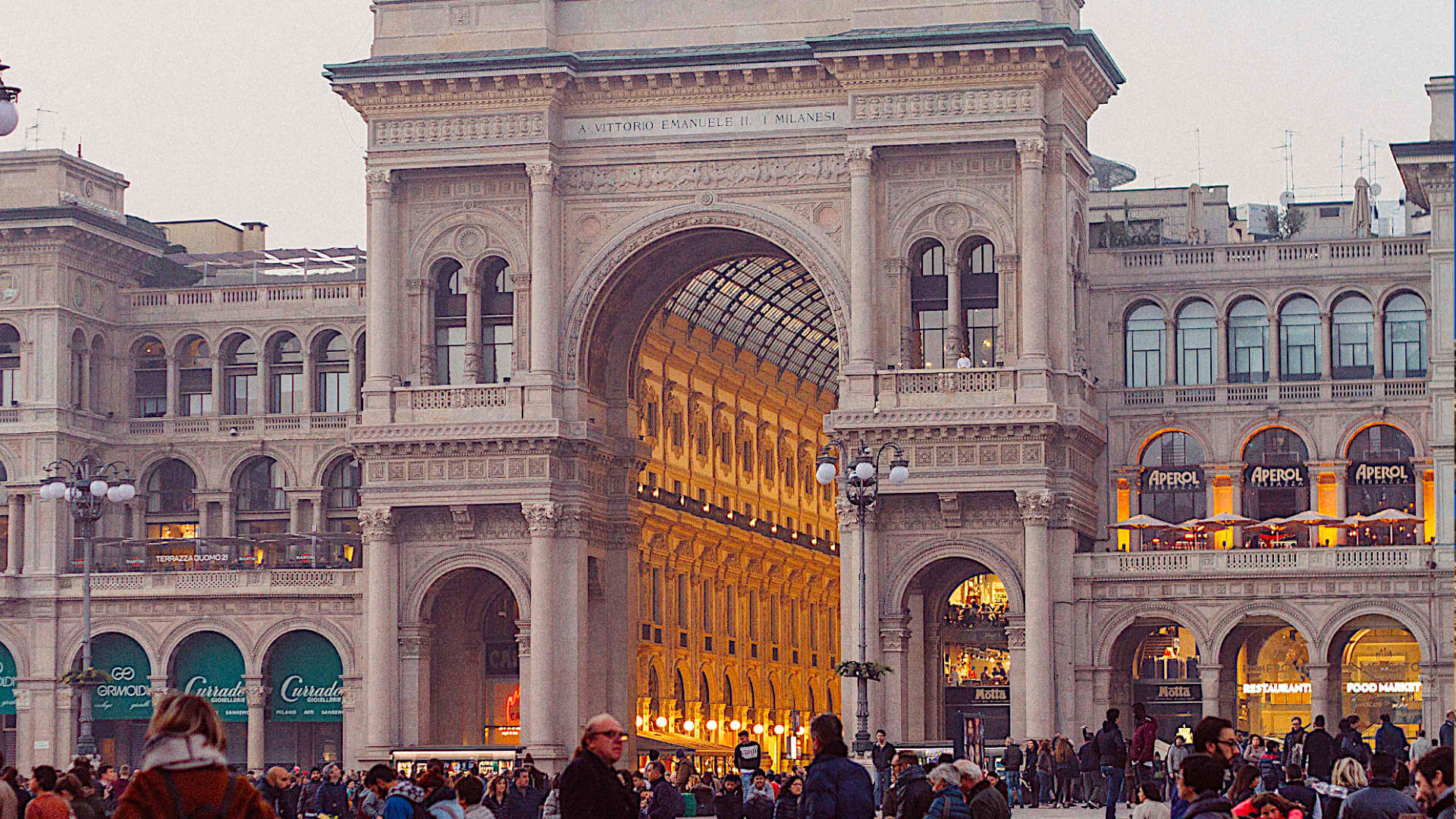
The great spaces of the Galleria foresaw a reality that has its distinguishing mark in the sense of movement. We can’t forget here, in the artistic field, a masterpiece such as “Riot in the Gallery” (Rissa in Galleria) by Boccioni, that represents reality in an innovative way, projected into a dynamic future. Cars, trams, work in factories: everything was changing the rhythm of the city and the people’s idea on everyday life.
Considered one of the sites of Milanese luxury shopping, along with Via Montenapoleone and Via della Spiga, it hosts many prestigious labels and brand shops, famous cafés and restaurants, as well as Feltrinelli Records, one of the largest megastores in Italy.
Taking that classic wander through the Galleria, the very heart of the city, as visitors have done for many years, still creates that wonderful sensation. Entering the Galleria, the corridor between Duomo and La Scala Theatre, its magnificent arch welcomes you and hints at the Milanese spectacle that lies within. The original idea of the designers was to create a porticoed street that would function as a showcase and offer somewhere to take a pleasant stroll, enjoy an aperitif or have dinner after the opera.
Today it can still be considered the “parlour” of the city, a place where you relax and enjoy a coffee at the bar Camparino, let yourself be enchanted by the cute hats of Borsalino and the collections of Prada and Louis Vuitton, or stop for an aperitif at Savini.
If you wish to return to Milan, the tradition suggests that you have a spin with your heel on the mosaic bulls “attributes” that make up the pavement of the Galleria’s splendid central octagon. Once a gesture to ward off evil, it has become part of the Milanese tradition and has such a following that a deep hole has formed in the pavement.
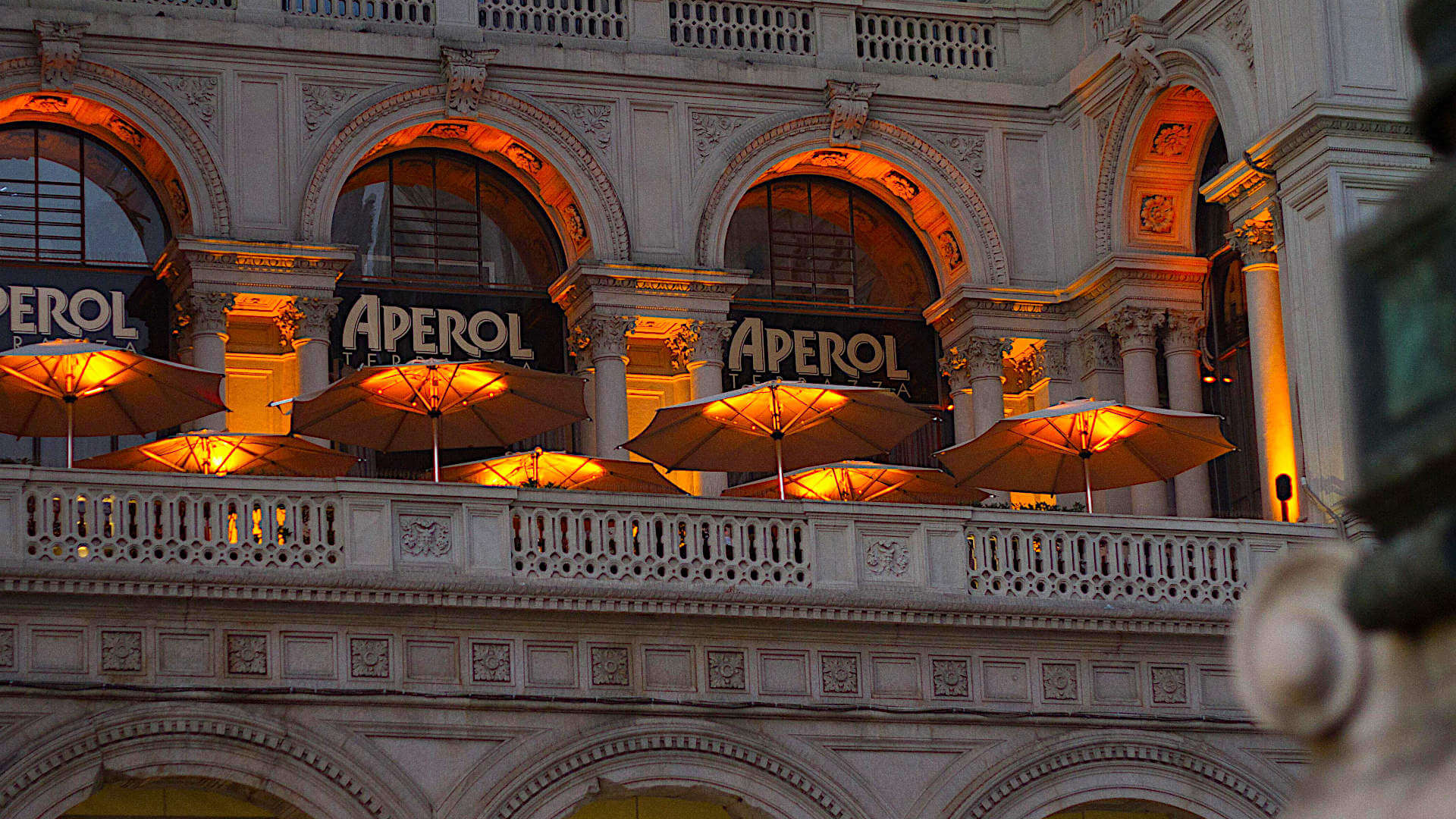
You will surely enjoy visiting the Galleria, it will also feel like turning the clock back in time: for the construction, which started in 1865 (by Giuseppe Mengoni) were used mainly iron and glass as for the Parisian train stations, a well-advanced technique in those days.
On occasion, the Galleria also offers shelter to its guests from sudden rain or from the hot sun, welcoming them in its extraordinary and elegant atmosphere.
The antique Milanese tradition included the custom of rubbing your foot on the pavement over the coat of arms that represents the city of Turin, on the left-hand side of the octagon. It was said to ward off evil.
Inside the Galleria, all the commercial activities must display an insignia with gold writing on a black background.
The structure of the Galleria is 32 metres high, comprises 353 tonnes of iron utilised for the skeleton of the cover, and its octagonal-shaped roof reaches a height of 47 metres.
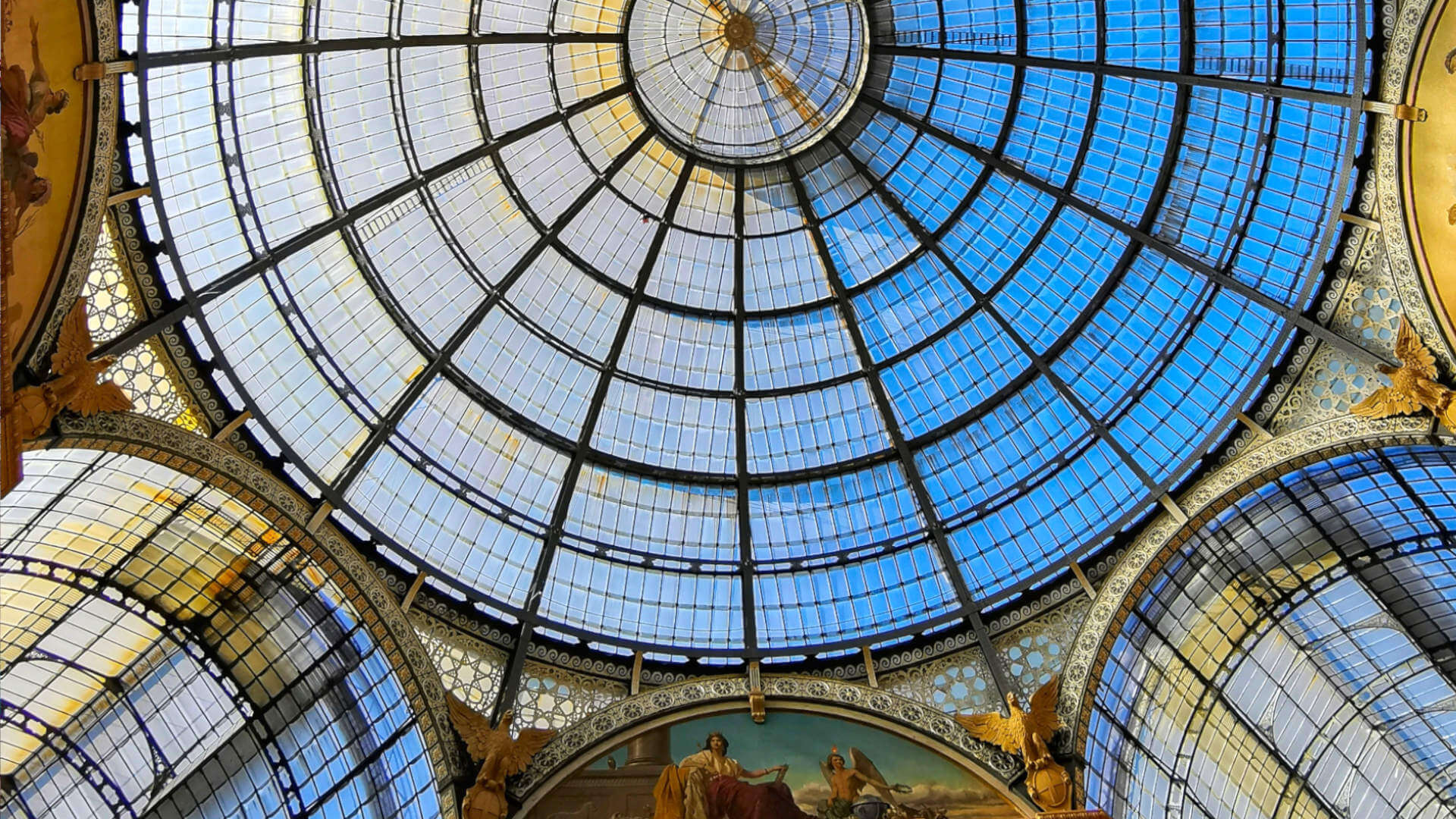
With a keen eye, it is possible to spot what remains of the original illumination installation. There are white spheres are on an elegant mounting in copper, which were once fed by gas.
Triennale Design Museum
The Triennale Design Museum (TDM) is an important museum located in Milan inside the Palazzo dell’Arte in Viale Alemagna 6. It was founded in 2007 by the Triennale di Milano to enhance, preserve, illustrate and explain Italian design with objects, people, companies, historical information, concepts and ideas that have made Italy a global point of reference in industrial design.
The museum is renewed cyclically once a year and every year the exhibitions face new themes, very different from each other, allowing to face the design of industrial production from different points of view.
The 2012 edition was entirely dedicated to Italian graphics.
Triennale Design Museum is the first Italian museum dedicated to design and is among the most relevant in the world. The museum was created with the aim of explaining what Italian design is, not only from a technical, design and aesthetic point of view but also exploring the historical, social context and the human part of it.
Along with the products also people, companies and values that have made the Italian style great in the world are displayed.
The exhibitions always convey messages from the designers and information about them or the companies’ history that often influenced an entire geographical area around them.
The museum also aims to stimulate the visitors to understand the designer, experiencing firsthand step by step how the idea became an object of common use.
The connection between person and design is always present in the museum: in all its editions, the relationship between the social, historical, economic and cultural context of Italy and the displayed object is constantly recalled, as well as the eternal bond between art, functionality and design.
The museum also has the responsibility and the duty to act as the nerve center of all the design heritage of Milan.
It also supports and promotes some business museums, as well as public and private collections, such as the Achille Castiglioni Studio Museum.
The purpose is therefore not to display lots of objects at a time but a few, focusing on them in depth, that’s why the museum changes every year with a new exhibition.
Great care for families with children: all the captions are placed at child height to involve young visitors also and illustrated books of the exhibitions are available.
Admission for children and teenagers is only 3 euros from 6 to 14 years, children up to 5 years old are free.
MUDEC
The Mudec, Museum of Cultures of Milan, is located into the former Ansaldo workshops in the Tortona area.
Inspired by the Amsterdam Museum, Mudec is the place where cultures from all over the world and the community meet, through visual and sound arts, design and customs of the people.
Vases, clothes, symbols, decorations and masks from all parts of the world are displayed in the permanent collection.
For families with children, visits and special workshops are available as well as summer camps.
MUBA
At the Milan Children’s Museum, MUBA, the children are stimulated towards creativity with fun activities that can also involve parents.
They can experiment, learn and find out through games and direct experience.
To do, to play, to think, to grow, to enjoy, to touch, to smell, to sniff, to listen, to exchange toys and also to have a birthday party. All the activities are developed to encourage and stimulate the children’s creative way of thinking.
Admission for a family of 4 persons is 25 euros.
WOW Spazio fumetto
It’s a very family destination where to discover the world of Peanuts with Charlie Brown & Company, Uncle Scrooge, Avengers and many others.
The rooms are equipped with tables to play, a tide of comics to read naturally, even a giant plastic model of La Scala and temporary exhibitions. Unmissable!
Quadrilatero della Moda
Quadrilatero della Moda or Fashion District includes four main streets, the most important is certainly via Monte Napoleone which is the most expensive and prestigious road in the world according to the “Main streets across the world” report, which tracks the top retail streets around the globe and ranks the most expensive internationally.
The sides of the square are formed by Via Montenapoleone, Via Manzoni, Via della Spiga and Corso Venezia.
Streets inside the Quadrilatero area include Via Borgospesso, Via Santo Spirito, Via Gesù, Via Sant’Andrea, Via Bagutta, and Via Baggutino.
This area is one of the most loved by tourists, citizens and fashion addicted of the world, as representative as the Brera district and the Navigli.
Getting to the Quadrilatero della Moda is easy: just take the metro line M3 and get off at “Montenapoleone” or the M1 line and get off at “San Babila”.
Most first-time visitors are simply awed and overwhelmed by the large concentration of haute couture labels. Countless clothing and jewelry stores, ateliers, showrooms and design spaces.
Millions of people come from all over the world, even just to walk around and take a look at the windows of the most famous brands on the market: from Armani, Versace, Alberta Ferretti, Dolce & Gabbana, Gucci and Chanel.
VIA MONTENAPOLEONE
The heart of the fashion district is undoubtedly via Montenapoleone which is as remarkable as the Champs Elysees of Paris or the Fifth Avenue of New York.
Previously known as the “Contrada del Monte”, from the 50s it began to become the fulcrum of the Milanese commercial activities.
Today it is one of the largest shopping centers for ready-to-wear and it’s the only street in the Quadrilatero della Moda open to car traffic.
Showrooms of Alberta Ferretti, Armani, Bottega Veneta, Valentino, Salvatore Ferragamo or Fratelli Rossetti, but also the shops, among others, of Cartier, Bulgari, Damiani, Audemars Piguet and Swatch are located there.
VIA ALESSANDRO MANZONI
Via Alessandro Manzoni follows the ancient route that led to the Porta Nuova from the Roman period and reached Piazza della Scala. Here there are the boutiques, among others, of Elisabetta Franchi, Martinelli, Emporio Armani, Gallo and Bottega del Cashmere. And also, craft shops, such as Arando Arte or Bolaffi, leather goods, such as Coccinelle, and home furnishings such as Artemide and Emporio San Firenze.
VIA DELLA SPIGA
Via della Spiga is entirely pedestrian, therefore closed to car traffic.
Here there are many showrooms especially of foreign designers. Some names? There are Fay, Tiffany & Co., Krizia, Gianfranco Ferrè, Miss Blumarine, Tod’s, Dolce & Gabbana, Roberto Cavalli, Piquadro, Kurt Geiger London and Ermenegildo Zegna.
Therefore, they are high fashion brands, not accessible to anyone, so many can’t do anything else but take a walk to window shop.
CORSO VENEZIA
Only part of this long road, which connects Piazza San Babila to Porta Venezia, is part of the Quadrilatero della Moda.
In addition to elegant clothing stores and jewelers, there are also exclusive restaurants where it’s quite common to meet Italian or foreign celebrities.
Braccialini, Nero Giardini, Prada, Dolce & Gabbana, Vivienne Westwood, Pirelli and Pinko are just some of the boutiques available in Corso Venezia.
L’Orto Botanico di Brera
In the seventeeth century the Brera palace and garden belonged to the order of the Jesuites.
The palace was a place of higher learning while the garden was used as an orchard and for growing medicinal plants.
Currently the Botanical Garden of Brera is a university museum with the aim of safeguarding a historical asset as a testimony of the cultural model of the 18th century.
This model provided for the transformation of Palazzo Brera and therefore of the institutions present in it, in a place of elaboration and synthesis of different knowledge.
For this reason, the University of Milan has been promoting projects and initiatives to safeguard the historical-scientific and historical-naturalistic heritage of Palazzo Brera since the early ’80s.
This is why the Brera Botanical Garden welcomes schools and groups of adults every day.
STRUCTURE
The botanical garden hosts events and activities for the public and schools. It is part, together with other 6 botanical gardens, of the Network of Gardens of Lombardy, an association that aims to design and develop joint cultural initiatives.
The main collection
In addition to the collections of hydrangeas and medicinal plants, the collection of numerous specimens belonging to the genus Salvia is particularly interesting.
Among the most interesting species are S. fulgens, S. sclarea, S. pratensis, S. dominica, S. transsilvanica, S. glutinosa, S. virgata, S. verticillata, S. elegans, S. nemorosa, S. verbenaca , S. guaranitica, S. frutucosa, as well as S. officinalis and its cultivars “Maxima”, “Argentea”, “Purpurascens”, “Icterina” and Tricolor “.
Among the most interesting species:
– two specimens (male and female) of Ginkgo biloba
– Juglans nigra
– Firmiana platanifolia
– Pterocarya fraxinifolia
Activities and Projects
Activities for the public:
guided tours on reservation and educational activities for schools of all levels.
Activities for the public:
– Course of botanical watercolor
– scientific dissemination seminars and environmental philosophy
Activities for schools by the staff of the botanical garden:
– plant adaptations
– classification of plants
– gamica and agamic reproduction
Projects in progress with the Network of Gardens of Lombardy:
– the sustainable garden
– tropics in Milan
– EST: educating in science and technology
NAVIGLI
Like Venice, Milan was once ringed and bisected by canals, most of the material used to build the Duomo and many other buildings in the city center were brought in via those waterways.
A couple of them still exist on the south end of town, and serious cleanup efforts over the years have created a delightful setting for visitors to enjoy, as well as inarguably the center of local youth culture.
The two canals, Naviglio Grande and Naviglio Pavese, are the main attractions, but the whole area is jammed with shops, bars, and restaurants.
Via Vigevano just north of the Naviglio Grande has some of the best shops, while Via Corsico is stuffed full people enjoying drinks most every night of the week.

